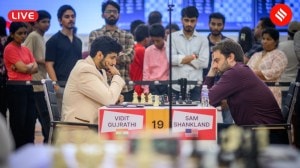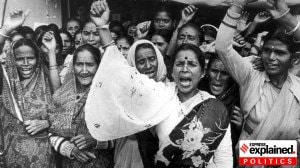Why Kejriwal lost: Pollution, lack of clean drinking water behind voter anger; two-thirds saw AAP as corrupt
According to Lokniti-CSDS Delhi Assembly election survey, more than half of the voters had made up their mind before the election campaign began, BJP built a strong coalition of upper castes and OBCs
 Delhi Election Results: Three important factors hence merit consideration in explaining the electoral verdict in Delhi (Express photo by Praveen Khanna)
Delhi Election Results: Three important factors hence merit consideration in explaining the electoral verdict in Delhi (Express photo by Praveen Khanna)The results of an election are often a by-product of who lost, and, in the process, who won. The just concluded Assembly elections in Delhi are a case in point. After a decade in power, the Aam Aadmi Party (AAP) saw a sharp decline in public support with the ‘credibility quotient’ of its leadership clearly taking a dip. A direct corollary to this development was a decisive victory for the BJP.
The Lokniti-CSDS Survey, carried out between January 29 and February 6 (the day after polling) and covering 3,137 respondents across 28 Assembly seats, showed that local issues were paramount among voters, there was anger against the AAP MLAs as well as dissatisfaction with its government, and that, contrary to the belief that the BJP surged ahead of the AAP in the final lap, more than half the voters had made their choice even before the campaign began. (An analysis of specific themes in detail follows.)
Three important factors hence merit consideration in explaining the electoral verdict in Delhi:
Firstly, this election was fought, lost and won on inherently local issues. In the second line of his victory speech on Saturday evening, Prime Minister Narendra Modi referred to “Yamuna Maiya”. In 2020, Kejriwal had made a solemn promise to cleanse the Yamuna, saying the voters could reject him the next time around otherwise.
His accusations of the river water being “poisoned” towards the fag end of the campaign were seen as a poor excuse and did not carry much weight, even as more than eight of every 10 respondents in the Lokniti-CSDS Survey raised problems associated with the Yamuna river as a concern.
Similarly, more than nine of every 10 respondents were disappointed with “the lack of cleanliness” in the city and more than eight of every 10 upset over pollution and the non-availability of clean drinking water.
Corruption charges levelled by the BJP and Congress against the AAP too played a role. Nearly two-thirds of the respondents saw the AAP government as corrupt, while a little over one in four (28%) felt it was very corrupt. Four of every ten saw the ‘Sheesh Mahal’ (the name given by the BJP to the CM’s residence after an allegedly exorbitant revamp by the AAP government) as a sign of wasteful expenditure.
Secondly, the AAP and its leadership faced a severe ‘credibility deficit’. Not just the defeat of the party but the defeat of its key leaders in their constituencies was an indicator of the same.
The incumbent AAP MLAs need to share the blame as the Lokniti-CSDS Survey showed that half the respondents were disappointed with the work done by their representatives. More crucially, nearly one in every three (35%) of those disappointed with their MLA’s performance were “strongly disappointed”. The ‘fatigue’ factor with the AAP, after nearly a decade in power, had clearly set in.
Moreover, the AAP itself was seen to have travelled a long journey in this decade. What started off as a party (and leadership) which had risen on an anti-corruption platform and prided itself as an alternative to mainstream political parties, ended up becoming one more alternative among mainstream political parties. The gap between the promise and performance, rhetoric and reality, aspiration and achievement was transparently evident.
The levels of satisfaction with the state and Central government were visibly different. The Lokniti-CSDS Survey indicated that if seven of every 10 respondents were satisfied with the work of the Central government, six of every 10 felt the same of the state government.
The data also indicated that more than half the respondents made a choice of whom to vote for much before the election campaign began. And that many of them voted for the BJP. Only one-fourth of the respondents decided on whom to vote for on the day of voting. These voters were closely split between the BJP and AAP.
Thirdly, the social coalition that the AAP had built up over Assembly elections appeared to have been strongly dented, to be replaced by a wider social coalition crafted by the BJP. The Lokniti-CSDS Survey indicated that the BJP built a strong coalition of upper castes and other backward classes. Save for the Gujjars and Yadavs, the BJP had a stronger presence among the other backward classes.
If the AAP was able to retain 22 seats, it had a lot to do with its support among the Dalits and the Muslims. The AAP continued with an eight-percentage point advantage over the BJP among the poor voters and a six-percentage point advantage among the younger (less than 25 years of age) voters. The BJP was far ahead in its support among the older voters (sixteen percentage points more than the BJP) and the rich (thirty-one percentage points). Among the middle class too, the BJP had a three-percentage point advantage over the AAP.
This support among the poor was also reflected in the endorsement of the work done by the AAP government in schools, hospitals and power supply.
It is interesting that the Congress, which was in power in Delhi for 15 years, has not opened its account now in three successive Assembly elections. Its spokespersons were more focused on discussing the AAP defeat rather than their own poor showing on Saturday.
The Lokniti-CSDS Survey also indicated that the Congress was viewed by respondents as an ‘also-ran’, a distant third factor in this election.
Overall, the AAP lost 40 seats with a ten-percentage point dip in its vote share, while the BJP gained 40 seats with a seven-percentage point gain in vote share. The fact that the BJP gave two seats to its alliance partners – the JD(U) and Lok Janshakti Party (Ram Vilas) – which they both lost, allowed for building a social coalition.
The Congress saw a marginal increase in its vote share, which adversely affected the AAP and consequently benefited the BJP. The fact that the BJP won one-thirds of its seats (16) by a margin of less than 10,000 votes as did the AAP (8 seats) indicates the three-way contest in a significant number of seats.
The Delhi voters also voted in line with the Lok Sabha polls this time, unlike the trends of 2019 (Lok Sabha), 2020 (Assembly) and 2014, 2015.
With the BJP firmly in the saddle, there will now be a ‘double engine sarkaar’ in place, so to speak. Taking forward the economic safety net put in place by the AAP government and resolving the pressing problems of the Delhi residents will clearly be the expectation of the Delhi voter from this comprehensive mandate to the BJP.
Sandeep Shastri is Director-Academics, NITTE Education Trust, and National Coordinator of the Lokniti Network; Sanjay Kumar is Professor and Co-director Lokniti-CSDS; and Suhas Palshikar teaches political science, is chief editor of the journal Studies in Indian Politics, and is a columnist for The Indian Express



- 01
- 02
- 03
- 04
- 05




























